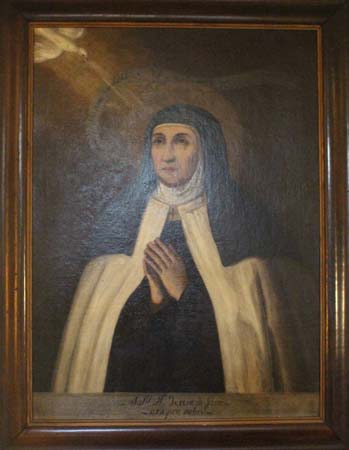The desire for intimacy and union with God in prayer is the compelling mark of Carmelite Spirituality. This has been true from the writing of the ancient Carmelite Rule in 1206 to the mystical writings of our great sixteenth century founders and reformers to the present day. It is the focus around which Teresa of Avila and John of the Cross have developed a comprehensive teaching on the life of prayer as a movement toward union with God.
Their writings teach us how to give ourselves over to the desire for God by nourishing a deep bond of friendship with Jesus Christ in prayer. It is in companionship and friendship with Christ that desire is slowly educated.


Intimate Sharing Between Friends
Prayer in my opinion is nothing else than an intimate sharing between friends; it means taking time frequently to be alone with him who we know loves us (Teresa of Avila, Life 8.5).
Fidelity to this relationship opens one to the educating power and presence of Jesus’ Spirit and calls for a determination to commit oneself in fidelity to a lifelong process of self-gift and transformation. In a purifying movement entailing not only light, consolation and affirmation, but also dryness, darkness and suffering, intimacy with Christ matures expanding consciousness and affectivity with a new kind of contemplative understanding, wisdom and selfless love.
Now a deepening identification with the suffering, crucified Christ brings about solidarity with the poor that is not only theologically grounded but actually experienced. In the darkness of this hidden presence of God, the self is broken open to embrace the victimized, the hopeless, the dispossessed, the suffering ones of the world.
Photo: Convento de Santa Teresa (Avila, Spain). Around 1554 Teresa had a profound experience in front of a statue of Christ at the pillar. She writes, “It happened to me that one day entering the oratory I saw a statue they had borrowed for a certain feast to be celebrated in the house. It represented the much wounded Christ and was very devotional so that beholding it I was utterly distressed in seeing Him that way, for it well represented what He suffered for us. I felt so keenly aware of how poorly I thanked Him for those wounds that, it seems to me, my heart broke. Beseeching Him to strengthen me once and for all that I might not offend Him, I threw myself down before Him with the greatest outpouring of tears” (Life 9.1).
Communion with God

This kind of redeemed love, leading to a profound communion with God in mutuality and love, effects, or makes available to our human perception and experience, the undeniable interconnectedness with everyone and everything in the universe.
Lover and beloved become one with all that is.
Listen to the words of St. John of the Cross:
The soul feels its ardor strengthen and increase and its love become so refined in this ardor that seemingly there flow seas of loving fire with it, reaching to the heights and depths of the earthly and heavenly spheres, imbuing all with love. It seems to it that the entire universe is a sea of love in which it is engulfed, for conscious of the living point or center of love within itself, it is unable to catch sight of the boundaries of this love (Living Flame 2.10).
John of the Cross
My Beloved, the mountains
and lonely wooded valleys,
strange islands,
and resounding rivers,
the whistling of love-stirred breezes.The tranquil night
at the time of the rising dawn,
silent music,
sounding solitude,
the supper that refreshes, and deepens love (Spiritual Canticle 14-15).
Transformation of Consciousness
A transformation of consciousness frees the person to place on the currents of human consciousness not violence, greed and hatred, but love, compassion and prophetic hope for a transformed community. The deepest dimension of Carmelite spirituality promises, therefore, a generativity that does not seek or expect its own consolation and fulfillment but rather is totally given over to the flourishing of the contemplative dimension within every human person and the continuing transformation of God’s people in love.
John of the Cross describes with extravagant passion what the larger shape of these emergent transformations and possibilities might be by focusing the hope-filled memory not on the past but on the Beloved One, the Christ, who approaches from the future with a mutuality and equality of loving between God/Christ and the person that spills over into works of love in and for the entire earth community.
John and Teresa Speak
There [God] will show her how to love him as perfectly as she desires. It is precisely by giving her his love that he shows her how to love as she is loved by him. Besides teaching her how to love purely, freely, and disinterestedly, as he loves us, God makes her love him with the very strength with which he loves her. God gives her his own strength by which she can love him. As if he were to put an instrument into her hands and show her how it works by operating it jointly with her, he shows her how to love and gives her the ability to do so (John of the Cross, Spiritual Canticle 38.4).
This is the reason for prayer, my daughters, the purpose of this spiritual marriage; the birth always of good works, good works. This is what I want us to strive for and let us desire and be occupied in prayer not for the sake of our enjoyment but so as to have this strength to serve (Teresa of Avila, Interior Castle 7.4).
This is the heart of Carmelite Spirituality.
Teresa’s Waters of Prayer
Our thirty-minute classic video, The Woman, The Water, and The Way provides an expressive and meditative overview of Teresa’s four waters of prayer, summarizing the heart of our spirituality.

